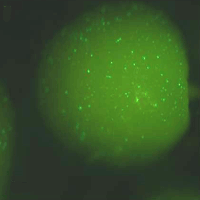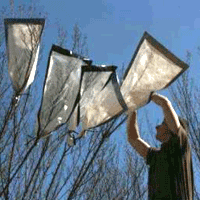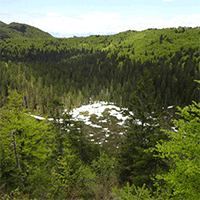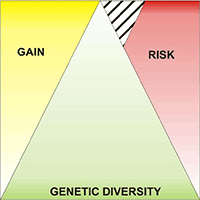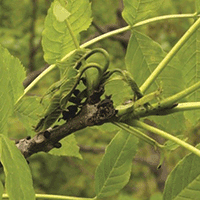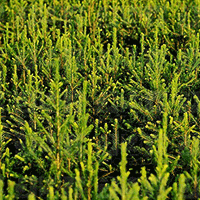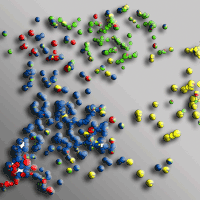For most plants transformation methods and regeneration protocols are readily available, leading to more complicated and differential research in plant science. The application of expression or RNAi constructs in biotechnology can lead to unwanted effects and detrimental phenotypes, which may cause great problems in the regeneration and breeding of transgenic plants. To circumvent this set back we resort to the transformation of inactive constructs. After the creation and establishment of transgenic lines the construct is specifically activated and the effects on the plants can be studied in detail, even if the resulting phenotype has harmful consequences. The activation of the constructs is carried out by means of induced site-directed recombination. The application of an heat shock leads to the expression of a recombinase, which excises the spacer fragment and leads to the desired effect on the plants. The feasibility of those constructs could be shown for RNAi, induced expression and even marker excision and confinement approaches demonstrating the huge variability of the new construct design.
Keywords
, , , , ,
Citation
Hinze A, Becker D (2012). Next generation biotechnology: how sophisticated constructs lead to further insights and new approaches towards biotechnology’s demands. iForest 5: 131-137. - doi: 10.3832/ifor0620-005
Academic Editor
Gabriele Bucci
Paper history
Received: Jan 24, 2012
Accepted: May 23, 2012
First online: Jun 13, 2012
Publication Date: Jun 29, 2012
Publication Time: 0.70 months
© SISEF - The Italian Society of Silviculture and Forest Ecology 2012
Open Access
This article is distributed under the terms of the Creative Commons Attribution-Non Commercial 4.0 International (https://creativecommons.org/licenses/by-nc/4.0/), which permits unrestricted use, distribution, and reproduction in any medium, provided you give appropriate credit to the original author(s) and the source, provide a link to the Creative Commons license, and indicate if changes were made.

Breakdown by View Type
(Waiting for server response...)
Article Usage
Total Article Views: 58777
(from publication date up to now)
Breakdown by View Type
HTML Page Views: 49190
Abstract Page Views: 3233
PDF Downloads: 4909
Citation/Reference Downloads: 16
XML Downloads: 1429
Web Metrics
Days since publication: 4918
Overall contacts: 58777
Avg. contacts per week: 83.66
Article Citations
Article citations are based on data periodically collected from the Clarivate Web of Science web site
(last update: Mar 2025)
Total number of cites (since 2012): 1
Average cites per year: 0.07
Publication Metrics
by Dimensions ©
Articles citing this article
List of the papers citing this article based on CrossRef Cited-by.
(1)
Araki H, Jearnpipatkul A, Tatsumi H, Sakurai T, Ushio K, Muta T, Oshima Y (1985)Site-specific recombinase, R, encoded by yeast plasmid pSR1. Journal of Molecular Biology 225: 25-37.
CrossRef |
Gscholar
(2)
Araki K, Araki M, Yamamura KI (2002)Site-directed integration of the cre gene mediated by Cre recombinase using a combination of mutant lox sites. Nucleic Acids Research 30 (19): e103.
CrossRef |
Gscholar
(3)
Broach JR, Guarascio VR, Jayaram M (1982)Recombination within the yeast plasmid 2mu circle is site-specific. Cell 29(1): 227-234.
CrossRef |
Gscholar
(4)
Capecchi MR (1989)Altering the genome by homologous recombination. Science 244 (4910): 1288-1292.
CrossRef |
Gscholar
(5)
Coppoolse ER, de Vroomen MJ, Roelofs D, Smit J, van Gennip F, Hersmus BJM, Nijkamp HJJ, van Haaren MJJ (2003)Cre recombinase expression can result in phenotypic aberrations in plants. Plant Molecular Biology 51: 263-279.
CrossRef |
Gscholar
(6)
Cuellar W, Gaudin A, Solórzano D, Casas A, Nopo L, Chudalayandi P, Medrano G, Kreuze J, Ghislain M (2006)Self-excision of the antibiotic resistance gene nptII using a heat inducible Cre-loxP system from transgenic potato. Plant Molecular Biology 62 (1-2): 71-82.
CrossRef |
Gscholar
(7)
Czarnecka E, Gurley WB, Nagao, RT, Mosquera LA, Key JL (1985)DNA sequence and transcript mapping of a soybean gene encoding a small heat shock protein. Proceedings of the National Academy of Sciences USA 82: 3726-3730.
CrossRef |
Gscholar
(8)
Dale EC, Ow DW (1992)Gene transfer with subsequent removal of the selection gene from the host genome. Proceedings of the National Academy of Sciences USA 88 (23): 10558-10562.
CrossRef |
Gscholar
(9)
Darbani B, Eimanifar A, Stewart CN, Camargo WN (2006)Methods to produce marker-free transgenic plants. Biotechnology Journal 2 (1): 83-90.
CrossRef |
Gscholar
(10)
De Lozanne A, Spudich JA (1987)Disruption of the Dictyostelium myosin heavy chain gene by homologous recombination. Science 236 (4805): 1086-1091.
CrossRef |
Gscholar
(11)
Fischer R, Budde I, Hain R (1997)Stilbene synthase gene expression causes changes in flower colour and male sterility in tobacco. The Plant Journal 11 (3): 489-498.
CrossRef |
Gscholar
(12)
Fladung M, Becker D (2011)Targeted integration and removal of transgenes in hybrid aspen (
Populus tremula L. x
P. tremuloides Michx.) using site-specific recombination systems. Plant Biology 12 (2): 334-40 Review. Erratum in: Plant Biology 2011 Jan 13 (1): 223.
CrossRef |
Gscholar
(13)
Fladung M, Schenk TMH, Polak O, Becker D (2010)Elimination of marker genes and targeted integration via FLP/FRT recombination system from yeast in hybrid aspen (
Populus tremula L. ×
P. tremuloides Michx.). Tree Genetics and Genomes 6 (2): 205-217.
CrossRef |
Gscholar
(14)
Gheysen G, Van Montagu M, Zambryski P (1987)Integration of
Agrobacterium tumefaciens transfer DNA (T-DNA) involves rearrangements of target plant DNA. Proceedings of the National Academy of Sciences USA 84: 6169-6173.
CrossRef |
Gscholar
(15)
Gidoni D, Srivastava V, Carmi N (2008)Site-specific excisional recombination strategies for elimination of undesirable transgenes from crop plants. In Vitro Cellular and Developmental Biology - Plant 44 (6): 457-467.
CrossRef |
Gscholar
(16)
Hinnen A, Hicks JB, Fink GR (1978)Transformation of yeast. Proceedings of the National Academy of Sciences USA 75 (4): 1929-1933.
CrossRef |
Gscholar
(17)
Hüsken A, Baumert A, Milkowski C, Becker HC, Strack D, Möllers C (2005)Resveratrol glucoside (Piceid) synthesis in seeds of transgenic oilseed rape (
Brassica napus L.). Theoretically Applied Genetics 111 (8): 1553-1562.
CrossRef |
Gscholar
(18)
Kerbach S, Lörz H, Becker D (2005)Site-specific recombination in
Zea mays. Theoretically Applied Genetics 111 (8): 1608-1616.
CrossRef |
Gscholar
(19)
Kolb AF (2002)Genome engeneering using site-specific recombinases. Cloning and stem cells 4 (1): 65-80.
CrossRef |
Gscholar
(20)
Kumar S, Fladung M (2002)Transgene integration in aspen: structures of integration sites and mechanism of T-DNA integration. Plant Journal 31 (4): 543-451.
CrossRef |
Gscholar
(21)
Leckband G, Lörz H (1998)Transformation and expression of a stilbene synthase gene of
Vitis vinifera L. in barley and wheat for increased fungal resistance. Theoretically Applied Genetics 96: 1004-1012.
CrossRef |
Gscholar
(22)
Louwerse JD, van Lier MC, van der Steen DM, de Vlaam CM, Hooykaas PJ, Vergunst AC (2007)Stable recombinase-mediated cassette exchange in
Arabidopsis using
Agrobacterium tumefaciens. Plant Physiology 145: 1282-1293.
CrossRef |
Gscholar
(23)
Lyznik LA, Mitchell JC, Hirayama L, Hodges TK (1993)Activity of yeast FLP recombinase in maize and rice protoplasts. Nucleic Acid Research 21 (4): 969-975.
CrossRef |
Gscholar
(24)
Ma BG, Duan XY, Niu JX, Ma C, Hao QN, Zhang LX, Zhang HP (2008)Expression of stilbene synthase gene in transgenic tomato using salicylic acid-inducible Cre/loxP recombination system with self-excision of selectable marker. Biotechnology Letters 31 (1): 163-169.
CrossRef |
Gscholar
(25)
Mayerhofer R, Koncz-Kalman Z, Nawrath C, Bakkeren G, Crameri A, Angelis K, Redei GP, Schell J, Hohn B, Koncz C (1991)T-DNA integration: a mode of illegitimate recombination in plants. The EMBO Journal 10 (3): 697-704.
Online |
Gscholar
(26)
Mette MF, Aufsatz W, van der Winden J, Matzke MA, Matzke AJ (2000)Transcriptional silencing and promoter methylation triggered by double-stranded RNA. The EMBO Journal 19 (19): 5194-5201.
CrossRef |
Gscholar
(27)
Mlynárová L, Conner A.J, Nap JP (2006)Directed microspore-specific recombination of transgenic alleles to prevent pollen-mediated transmission of transgenes. Plant Biotechnology Journal 4: 445-452.
CrossRef |
Gscholar
(28)
Nern A, Pfeiffer BD, Svoboda K, Rubin GM (2011)Multiple new site-specific recombinases for use in manipulating animal genomes. Proceedings of the National Academy of Sciences USA 108 (34): 14198-14203.
CrossRef |
Gscholar
(29)
Paszkowski J, Baur M, Bogucki A, Potrykus I (1988)Gene targeting in plants. The EMBO Journal 7 (13): 4021-4028.
Online |
Gscholar
(30)
Puchta H, Swoboda P, Gal S, Blot M, Hohn B (1995)Somatic intrachromosomal homologous recombination events in populations of plant siblings. Plant Molecular Biology 28 (2): 281-292.
CrossRef |
Gscholar
(31)
Russell SH, Hoopes JL, Odell JT (1992)Directed excision of a transgene from the plant genome. Molecular and General Genetics 234 (1): 49-59.
Online |
Gscholar
(32)
Salomon S, Puchta H (1998)Capture of genomic and T-DNA sequences during double-strand break repair in somatic plant cells. The EMBO Journal 17 (20): 6086-6095.
CrossRef |
Gscholar
(33)
Schmidt N, Merker M, Becker D (2012)Novel high-throughput RNAi vectors for plant biotechnology. Plant Breeding (early view)
CrossRef |
Gscholar
(34)
Schreiber DN, Bantin J, Dresselhaus T (2004)The MADS box transcription factor ZmMADS2 is required for anther and pollen maturation in maize and accumulates in apoptotic bodies during anther dehiscence. Plant physiology 134: 1069-1079.
CrossRef |
Gscholar
(35)
Smith NA, Singh SP, Wang MB, Stoutjesdijk PA, Green AG, Waterhouse PM (2000)Total silencing by intron-spliced hairpin RNAs. Nature 407 (6802): 319-320.
CrossRef |
Gscholar
(36)
Smithies O, Gregg RG, Boggs SS, Koralewski MA, Kucherlapati RS (1985)Insertion of DNA sequences into human by homologous recombination. Nature 317 (6034): 230-234.
CrossRef |
Gscholar
(37)
Song H, Niederweis M (2007)Functional expression of the Flp recombinase in
Mycobacterium bovis BCG. Gene 399 (2): 112-119.
CrossRef |
Gscholar
(38)
Sternberg N, Hamilton D (1981)Bacteriophage P1 site-specific recombination: I. Recombination between loxP sites. Journal of Molecular Biology 150 (4): 467-486.
CrossRef |
Gscholar
(39)
Takano M, Egawa H, Ikeda JE and Wakasa K (1997)The structures of integration sites in transgenic rice. Plant Journal 11 (3): 353-361.
CrossRef |
Gscholar
(40)
Thomas KR, Capecchi MR (1987)Site-directed mutagenesis by gene targeting in mouse embryo-derived stem cells. Cell 51 (3): 503-512.
CrossRef |
Gscholar
(41)
Van Ex F, Verweire D, Claeys M, Depicker A, Angenon G (2009)Evaluation of seven promoters to achieve germline directed Cre-lox recombination in
Arabidopsis thaliana. Plant Cell Report 28 (10): 1509-1520.
CrossRef |
Gscholar
(42)
Vergunst AC, Hooykaas PJ (1998)Cre/lox-mediated site-specific integration of
Agrobacterium T-DNA in
Arabidopsis thaliana by transient expression of Cre. Plant Molecular Biology 38: 393-406.
CrossRef |
Gscholar
(43)
Wang Y, Yau YY (2011)Recombinase technology: alications and possibilities. Plant Cell Report 30: 267-285.
CrossRef |
Gscholar
(44)
Waterhouse PM, Graham MW, Wang MB (1998)Virus resistance and gene silencing in plants can be induced by simultaneous expression of sense and antisense RNA. Proceedings of the National Academy of Sciences USA 95 (23): 13959-13964.
CrossRef |
Gscholar
(45)
Wesley SV, Helliwell CA, Smith NA, Wang MB, Rouse DT, Liu Q, Gooding PS, Singh SP, Abbott D, Stoutjesdijk PA, Robinson SP, Gleave AP, Green AG, Waterhouse PM (2001)Construct design for efficient, effective and high-throughput gene silencing in plants. Plant Journal 27 (6): 581-590.
CrossRef |
Gscholar
